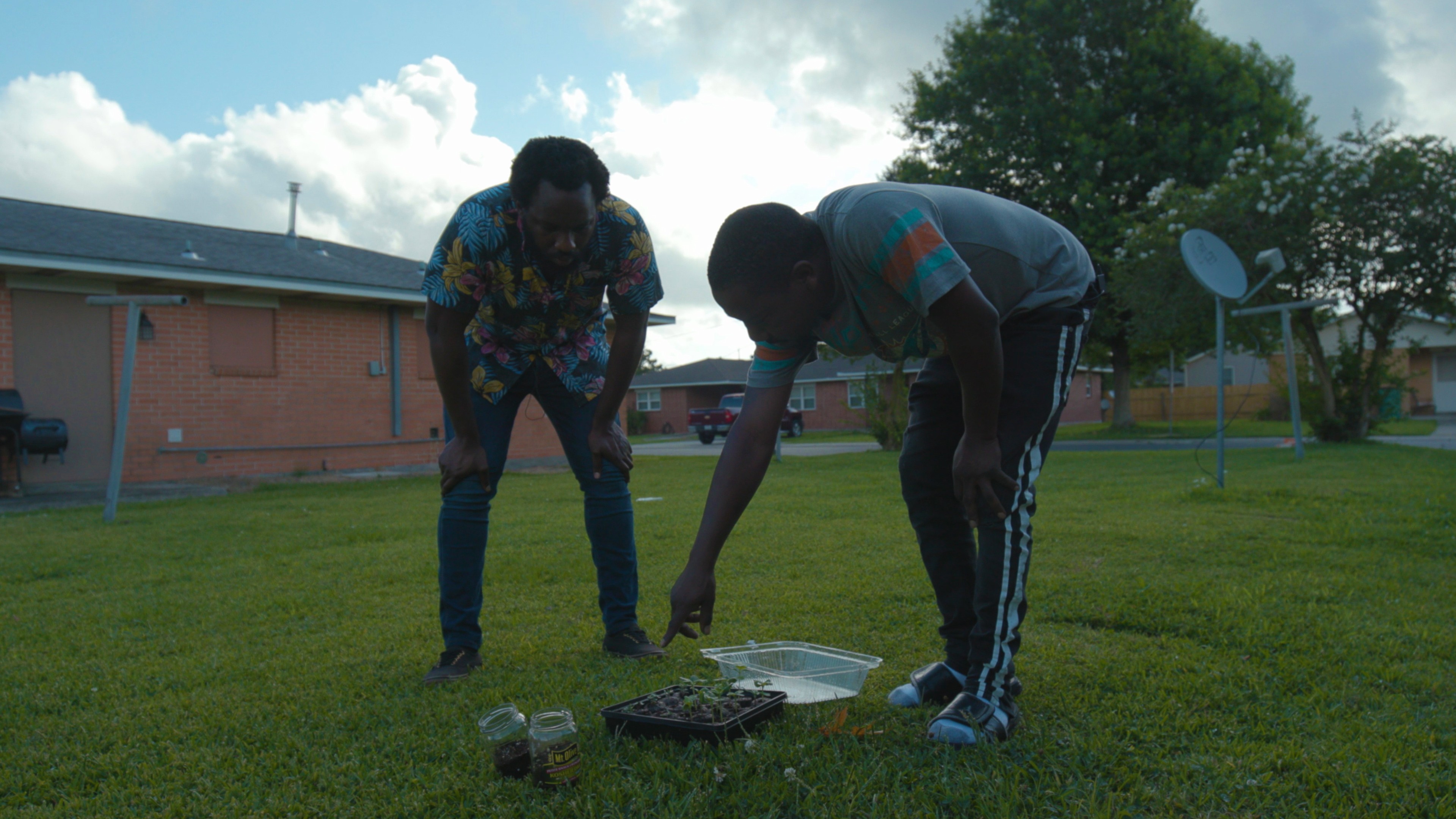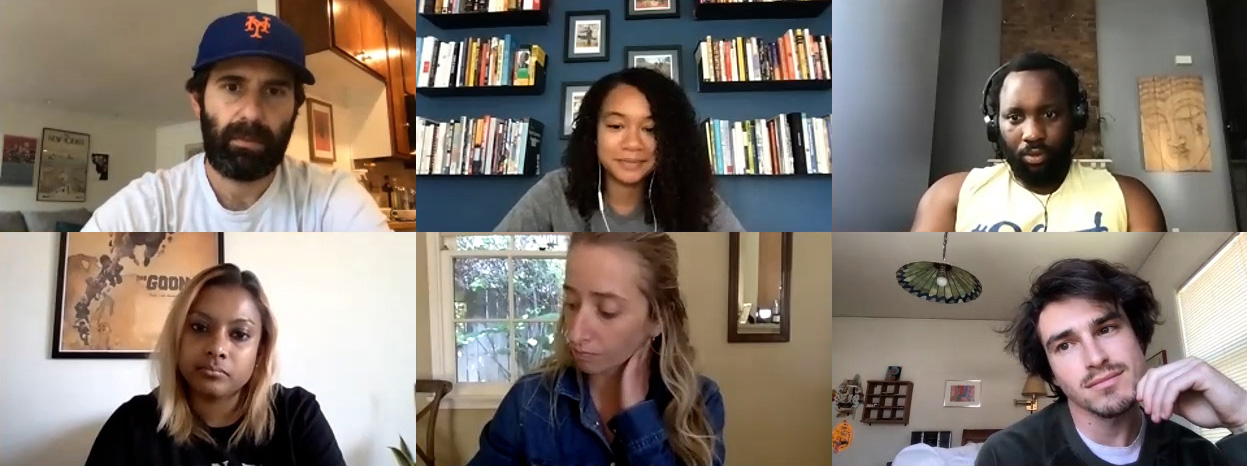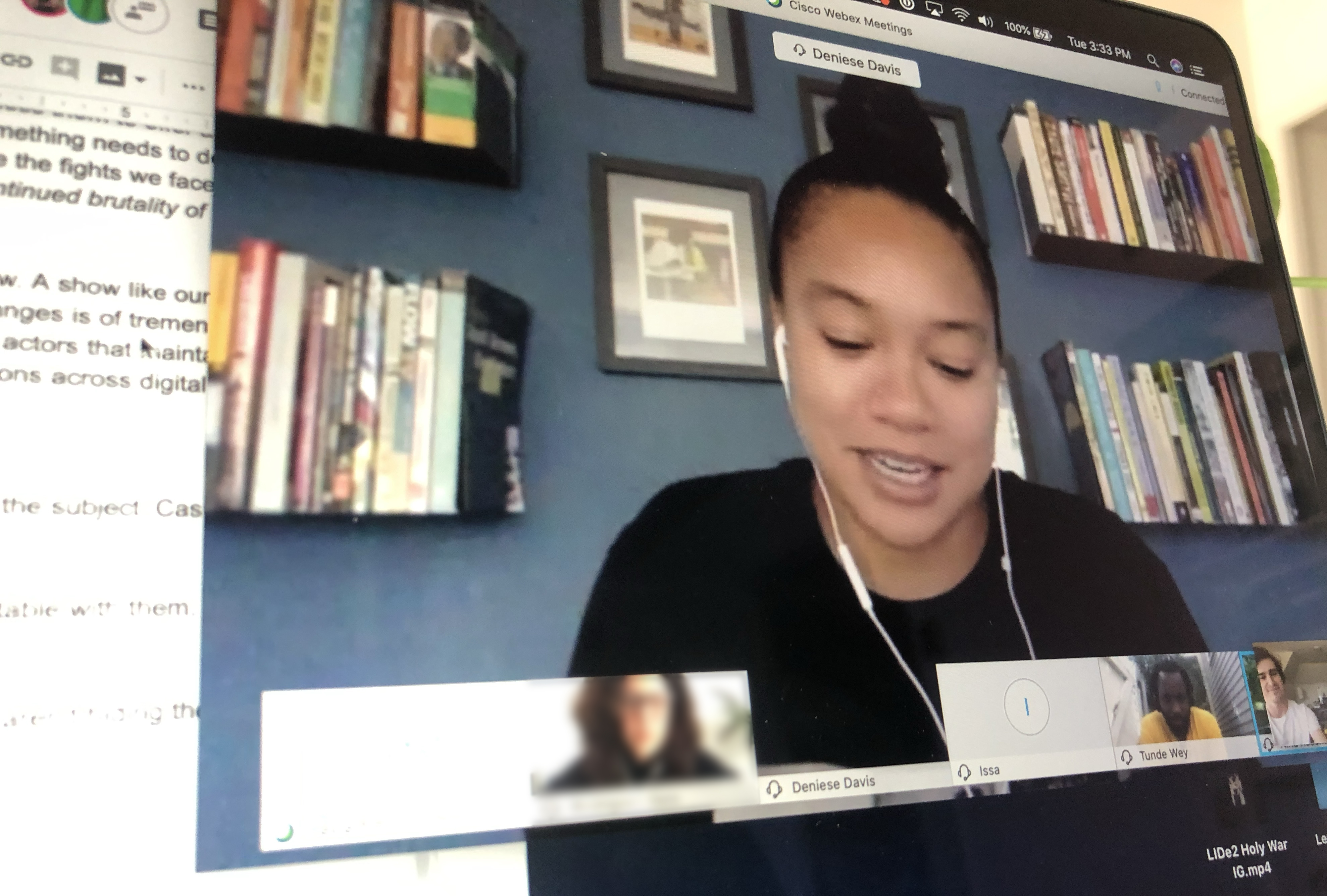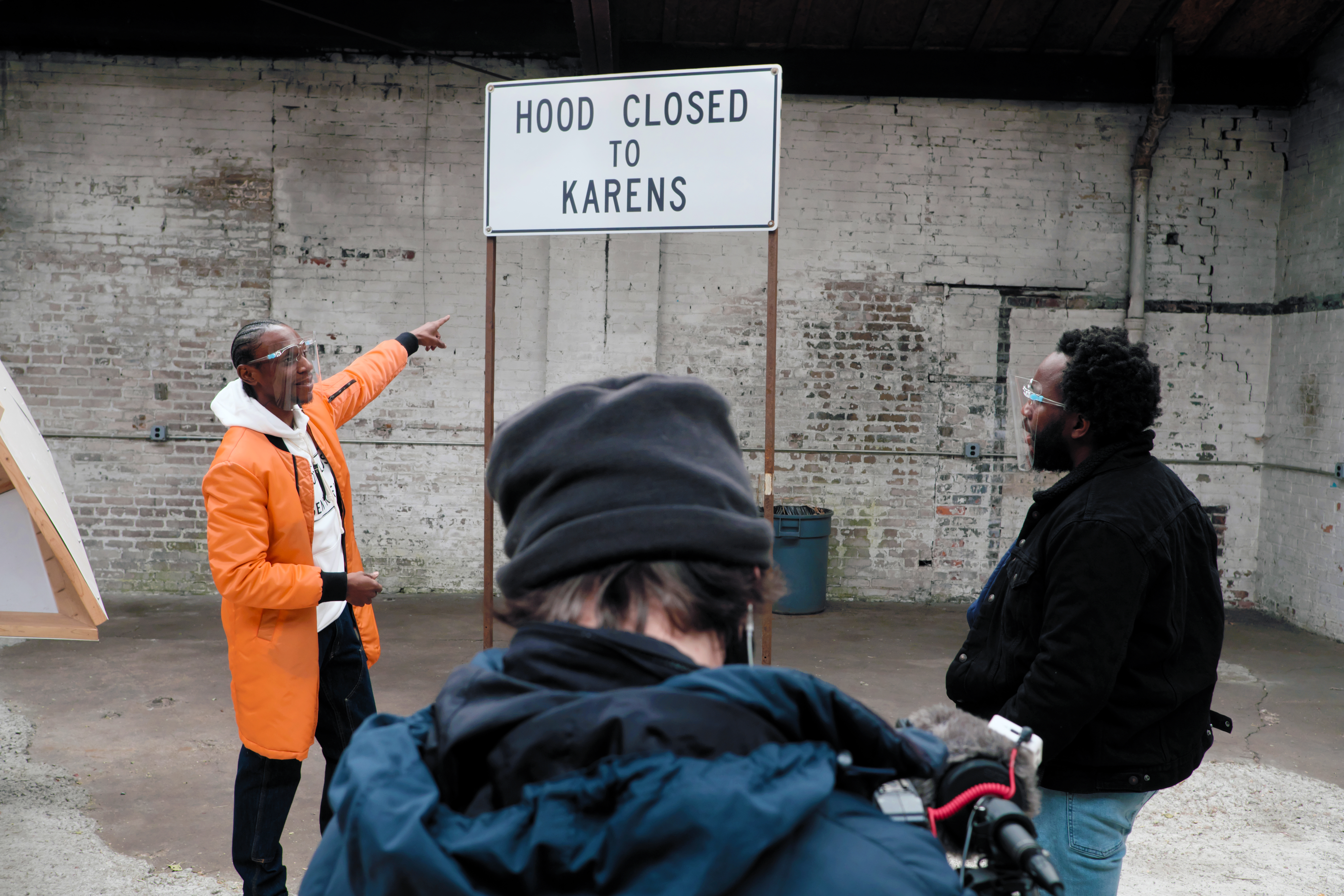

Tunde Wey interviews juice bar owner Dylan Maisel in New Orleans in November 2019. Credit: Theo Schear.
Hard to Swallow is an independent docuseries fronted by Tunde Wey, a chef and writer known for projects addressing race and class inequity. I’ve been producing Hard to Swallow with Tunde for more than four years, and this diary recounts incredible highs, devastating lows, and our tumultuous relationship with the television industry. Hard to Swallow is funded by the Ford Foundation and Pop Culture Collaborative, and supported by IFP (now the Gotham) and SFFILM. At the time of publication, we are editing the fourth of twelve episodes and planning a screening tour for 2024.
Before Hard to Swallow, I was making social media videos for my own amusement. My day job still required me to be in an office 40 hours a week, and I was doing freelance videography on the side. As part of the national documentary unit at Detroit Public Television, I worked on PBS documentaries, but I had never attempted my own longform project. I was seeking a nonfiction endeavor to devote myself to.
November 2016: In San Francisco, a friend hosted one of Tunde Wey’s Blackness in America dinners and invited me to be a server. I didn’t meet Tunde that night, but the conversation I heard while serving stuck with me. I had just turned 25.


May 2019: I was seated next to Tunde at a gala. I had made the fundraiser video for the event and he was invited by our mutual friend. We briefly chatted about the 2016 dinner, and I mentioned a documentary I was starting to develop (but never produced) about Piedmont, California, a tax-haven city within Oakland.
That summer, seeking inspiration for my Piedmont project, I read up on Tunde’s work. Tunde had a portfolio of creative interventions: he charged white people higher prices at food stalls commensurate with regional wealth inequality; he set up blind dates between citizens and undocumented people; and he sold chicken for a deed to a house to counteract gentrification. One article mentioned that Tunde was interested in developing a docuseries about his dinners.
August 2019: I emailed Tunde asking for advice about the Piedmont project, and if some kind of documentary about his work wasn’t already underway, whether he’d be interested in working on that together. We got on the phone soon after and came up with Hard to Swallow. Our mutual friend said it sounded pornographic.
The first treatment I put together imagined a show where Tunde would devise a “reparatory twist” for a dinner event catered to each episode’s location. At first, I created two budgets: a “lean” production for $3,000/episode and a “heavy” production for $8,000/episode. They included pro bono white labor, which felt aligned with the spirit of Tunde’s work. Eventually, we landed on a $18,000/episode budget that did not rely on uncompensated labor (to avoid complications with fundraising) and sent it to a few culture funders that Tunde had recently met at a conference.
November 2019: I flew from Oakland to Chicago for about 16 hours to film one of Tunde’s dinners. This footage became central in establishing his character in the project because he has rarely hosted dinners since then. Eight days later, I flew to New Orleans and slept on Tunde’s couch for a week. He put together an ambitious itinerary of 17 interviews over five days. I didn’t understand it at the time, but he was tying the larger story of food gentrification into his own experience opening a stall at the St. Roch Market, a food hall in New Orleans.
At that point, I imagined the project as updating Bourdain with critical race theory and uncomfortable confrontations. When I got home from New Orleans, I put together a teaser and we came up with a slogan: “a food show not about food.” Our roles were yet to be defined, but we were effectively co-directors, producers, and everything else. We were looking for a third partner for the project and briefly collaborated with a photographer and writer that Tunde knew, but the synergy wasn’t quite there.
January 2020: Because we considered Bourdain the peak of food programming, our first target was the production company behind Parts Unknown. A producer showed initial interest: “I love the concept of the show and would love to chat with you about it.” But after one phone call, our next many messages went unanswered.
March 2020: We paused our longform ambitions to release short films about the unfolding devastation of the pandemic. Let It Die, our series of shorts, took its title from an essay Tunde posted on Instagram endorsing the death of the current restaurant industry in favor of a less exploitative model. The first episode followed Reem Assil, a Palestinian restaurateur in the Bay Area who was considering a transition to a worker-owned model. I applied to the ITVS Short-Form Open Call with the project.


April 2020: Tastemade, a food entertainment studio, was the first to offer a shopping agreement for six months, which we negotiated down to three. Together we would pitch the project to streamers and networks, and if greenlit, they would run production services, shepherd the project through its release, and take a large portion of the profit. They told us that “this could be the next Tiger King.” In place of an eccentric zookeeper involved in a murder-for-hire, it was a Nigerian chef investigating twisted but normalized expressions of systemic racism—comparably spectacular, apparently. I was in favor of accepting their agreement, allured by the thought of creating the next cultural phenomenon, but Tunde saw through the wild comparison and wanted to explore other options first.
May 2020: Tunde was interviewed about his apathy for the restaurant industry in the New Yorker, and the first episode of Let It Die started racking up views. During a quick trip to New Orleans, we invited a new collaborator to become the third partner and eventually created an LLC called Run It Up Productions in which we were three equal shareholders. Deniese Davis, the producer of Insecure who was working within Issa Rae’s HBO overall deal, saw the New Yorker article and messaged Tunde on Instagram offering to pitch our show to HBO.
We were filming our second short when news broke that George Floyd had been murdered by a police officer. White people (like me) saw buildings burn in Minneapolis and started reading Instagram posts about how to be better white people. We also had our first call with Deniese. She estimated $500,000 USD per episode. We briskly added more episodes to the pitch deck. Tunde’s previously radical perspective now had mainstream appeal. Was Tunde going to be the next Tiger King after all?
June 2020: A midlevel production company offered $5,000 USD to option the show for 24 months, meaning they would hold exclusive rights to pitch the project to buyers, but our third partner wasn’t sold on them and we immediately had many more prospects.

It was bizarre to be thriving amidst so much crisis. The country was reeling twice over from a life-threatening contagion and a white-threatening reckoning, but we seemed on the precipice of unimaginable success. Through a mutual friend of our third partner, we were connected to a team of execs at Film45, one of Hollywood’s biggest nonscripted production companies. As a preferred vendor of all the major platforms, they could secure pitch meetings with anyone we wanted. Companies like Issa Rae Productions (IRP) and Film45 typically work within exclusive shopping agreements, but for our project they were willing to collaborate. IRP would cover WarnerMedia platforms such as HBO, HBO Max, and CNN, while Film45 would take on Netflix, FX, Apple TV, National Geographic, and anything else. No shopping agreements were needed.
We were attempting to sell a TV show as first-time filmmakers, and our industry allies suggested that we somehow attach a well-known EP (we never found one). They also told us that independent television is an untrodden trail in the media landscape because studios want to be involved as early as possible to ensure production standards, among other things. We considered packaging Hard To Swallow as a feature, a limited series, or a returnable series. They said series tend to be more lucrative, and we wanted an ongoing project anyway.
June 9–September 2, 2020: After a few strategic planning sessions with IRP and Film45, their respective assistants scheduled a total of seven pitch meetings. HBO was up first, and Issa would be joining the call as a show of support. In prior times, these meetings happened in Los Angeles, but everything was remote now. With her camera off, Issa shared a few words of encouragement and Deniese gave a strong pitch for the project. Then it was left to Tunde to compel the gatekeepers of America’s most premium television platform. I remember him talking about the stories he was interested in telling. I only said a few words and shivered nervously, nonetheless. The execs gave little indication of their interest and said they’d let us know in a week or two, but Deniese said it went well.
In the liminal state between pitch and verdict, I imagined my glorious new life. This was my first longform project and it felt like a home run off the bat. After this kind of directorial debut, I’d enter the highest pantheon of filmmakers. Maybe I would be the next Tiger King. Two weeks later, Deniese broke the hard news that HBO had passed. I don’t remember why.

The second pitch was HBO Max, HBO’s younger and less traditional sibling. I had a mutual friend with one of the execs, but I didn’t dare waste time with small talk. Each pitch went more or less the same: Deniese or our Film45 reps would offer their excitement for the unique and timely project; Tunde would share the story of his work, the genesis of the show, and what he wanted to do; the buyers would ask a few poker-faced questions and say they’d get back to us. The lead exec at FX gave us hope when she broke into tears about her own struggles that were somehow tangentially related. But every pitch led to the same disappointment: a pass.
There was much rumination about why the show wasn’t bought. The most common feedback from the commissioners was that they already had similar projects or had filled their food show quota. My assumption is that Tunde wasn’t famous enough, on top of the fact that neither of us have any filmography to lean on. We also speculated that things might have gone differently if even one of the many commissioners we pitched to were Black. Instead of bringing Hard To Swallow to the world, in the following months HBO Max announced a lighthearted food show with Selena Gomez.
July 2020: We heard back from the ITVS Open Call. ITVS greenlit Hard To Swallow at $150,000 USD for six episodes between 20 and 24 minutes. They told us this was much more than they’d ever funded shortform content, as they typically only funded pilot episodes. They would get one year of exclusive streaming rights and profit-sharing that seemed unfavorable, and any derivative work in the next five years would be subject to the same terms. I was again in favor of taking the deal because it was a lot more than nothing, but our ambitions had evolved and my two collaborators wanted to continue testing the waters.
August 2020: Tunde received an email from a senior program officer at the Ford Foundation. They had met at an artist retreat the year before, and the foundation had come up with $300,000 USD for the project. The funding was completely unrestricted and only subject to a couple of rounds of financial reporting. Just a couple of weeks later, our angels at the Ford Foundation gathered more funding from other departments, bringing the total grant to $450,000 USD.
September 2020: At IFP [now Gotham] Week’s Spotlight on Docs, a four-day (virtual) marketplace that scheduled up to 12 meetings per day for us, I connected with people from Sundance, Netflix, Endeavor Content, Field of Vision, CNN Films, SFFILM, Black Public Media, and many boutique distributors. The meetings yielded valuable connections, including an international sales agent at a boutique agency called Reservoir Docs who gave us an estimate of €177,513 to €410,602 per episode for global sales outside North America.
October 2020: With the Ford Foundation funding, we didn’t need Hollywood anymore—we would do it ourselves. I do wonder what the studio version of this show would’ve been, but I’m also grateful we had the unadulterated opportunity to explore Tunde’s interests. We spent a couple of weeks in Lake Tahoe for preproduction, turned down the ITVS deal, and submitted to Sundance an episodic program with a deadline extension. The encouragement of our contacts at Sundance had us optimistic about our chances.

November 2020: Our six-week production trip started in Detroit around Thanksgiving. After a jam-packed couple of weeks filming 23 interviews, we flew to El Paso. I received a rejection email from Sundance while on my way to FedEx. Around the same time, our third partner and I were accepted for the 2021 SFFILM FilmHouse Residency.
December 2020: Another $100,000 USD came from a different funder focused on narrative change, Pop Culture Collaborative. $550,000 USD isn’t much for a mainstream serial, but for three first-time filmmakers left to our own devices, it was more than plenty. Keeping with the spirit of prioritizing Black folks, we only hired Black freelancers. I kept my day job and didn’t take a salary, but I did reimburse myself $17,834.14 USD of the roughly $30,000 USD I had invested in the project before it was funded. Through principal photography, we spent about $100,000 USD on production.
Near the end of the trip, I tested positive for COVID-19 on Christmas Day at a family gathering in suburban Lagos and things fell apart. Interpersonal issues limited progress for 18 months.
January 2021: The SFFILM FilmHouse Residency started, but we only participated for a few months before I left the project and we dropped out of the residency.
July 2022: Tunde and I reconnected over the possibility of starting new short film projects, but we ended up returning to Hard To Swallow instead.

August 2022: Tunde stayed with me in Oakland for almost four months while we wrote and edited Hard To Swallow into three one-hour episodes. Maybe a little Hollywood structure would have saved us from the drama, but drama is entertainment, so we’ve added behind-the-scenes turmoil and our editing process as a reflexive storyline in the show. It isn’t just about Tunde anymore, it’s also about trying to make an indie TV show.
November 2022: With the new pilot, we hopped over to the UK to attend a television industry conference called Content London. We knew nothing about it, but for Tunde it was on the way back to Lagos, and they offered us a discount on the registration fee. Like IFP Week, we could sign up for meetings with representatives from major entities in the industry, but at Content London you could sign up for a maximum of three 15-minute “Speed Meetings.” Because we signed up late, we only got one meeting with an executive from Fremantle, a multinational production and distribution company. However, through the conference web portal, we could message other attendees, including major television execs from around the world. Tunde employed a signature strategy from his career as a touring chef: nonchalant, provocative email blasts urging the recipient to support his work. By the time an administrator deleted his entire outbox and threatened to revoke his registration, a handful of fellow attendees had already taken the bait, including a couple of high-level Canadian producers.
The trip wasn’t entirely a waste. We’re always praying for a champion on the inside to save us from oblivion, and the Canadian producers were very accomplished and eager to help. They drafted us a financial plan and made some connections, but so far nothing has come of that either.
January 2023: Through one of Tunde’s old contacts at Eater, we were connected to an unscripted executive at Vox Studios. She was excited by our materials and set us up with the studio heads, but was let go before our meeting due to downsizing. The heads seemed interested in the project, but told us that streamers were trying to get rid of shows, not buy new ones, so they felt it wasn’t viable in the current market.
June 2023: Tunde stayed with me again for two months and we rewrote the show into twelve episodes. Our plan had been to turn it into a feature doc so we started breaking it into acts, but we quickly realized that our ambitions didn’t fit into a feature format. Each episode is now about 30 minutes and driven by lyrical narration and a cinematic score.
August 2023: At an annual artist retreat in New Mexico, where Tunde originally met both of our eventual funders in 2019, we screened the first two episodes of the new Hard to Swallow. It was vulnerable to present a four-year-old project to strangers for the first time, but the response was overwhelming. They validated us with standing ovations and deep engagement at a time when we needed it.
September 2023: We’ve continued to connect to streamers, hoping for the right person to champion our project. Someone at Netflix recently responded, “This approach is slightly too academic and dense for Netflix.” I understand that it’s not Selena Gomez in a kitchen. And it definitely won’t be the next Tiger King.
At the retreat in New Mexico, one enthusiastic member of the audience turned out to be a former deputy director of the New Museum, and she was keen on helping. We’ve hired her as a consultant to design and fundraise for a grassroots screening tour.
I’ve come to appreciate just how narrow the road to distribution is for independent media. The folks leading the documentary division at Endeavor Content (now Fifth Season) once told me that they’re really only interested in valuable IP. So if the subject of your film isn’t already well-known, it’ll take a miracle to find a major audience. The even narrower proving ground for episodic projects at film festivals makes distribution for independent serials almost impossible.
Having tried almost everything twice, we may have to settle for self-distribution, but I’ll be happy as long as we finish editing the whole show. Each new development will be part of an episode someday.
Theo Schear is a documentary filmmaker from Oakland, California. He was a 2021 SFFILM FilmHouse Resident and a member of Detroit Public Television's national documentary unit.




